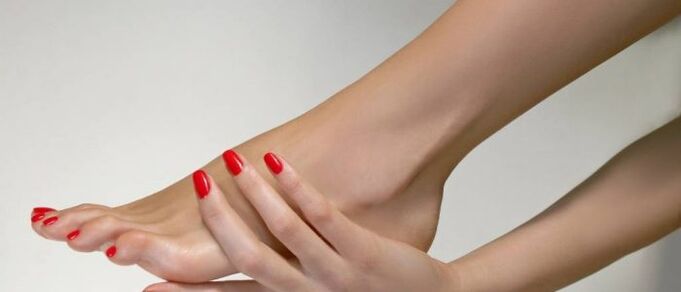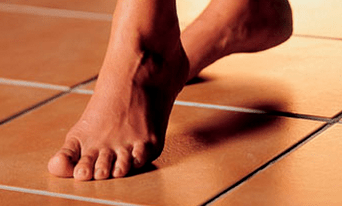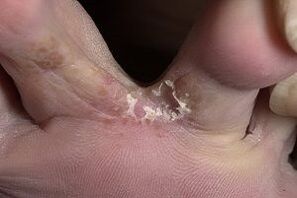If a person has fungus on his or her feet, it is important to start timely and adequate treatment. The fact is that fungal diseases of the skin of the feet are contagious, and if you do not start fighting the disease right away, all family members of the patient are at risk of getting an infection. Treatment is prescribed by a doctor, it will depend on the type of pathology, the degree of damage to the skin, as well as the general condition of the person.

The cause of the appearance of fungus on the feet
When it enters the skin of the feet, the fungus does not always cause mycoses, and in order for the first symptoms to appear, negative factors must affect the human body. The following negative causes affect the development of mycosis:

- weakens the body's immune system;
- heavy and toxic drug use;
- not following the rules of foot and toe hygiene;
- the presence of cracks, cuts and abrasions on the toes and feet, where fungal spores can enter the body.
Fungal infections are the wet floors of the pool, baths and showers in the gym.
Fungal infections enter the body by way of household contact, when an adult or child comes in contact with a sick carrier or an object inhabited by fungal spores. Often, foot fungus can be picked up in public places - dressing rooms, showers, swimming pools, on the beach. The disease can also pass when wearing other people's shoes, where pathogenic spores live. Failure to adhere to basic hygiene rules leads to undesirable consequences that trigger fungal pathology on the feet and toenails. The carrier may not always be able to find out in a timely manner that he or she has foot fungus, as the symptoms appear only under a combination of unfavorable conditions. But such people are still contagious, and this is dangerous for loved ones who are also at risk of getting a contagious infection.
Symptoms and types
Foot mycosis is in the following forms:
- kuasimus;
- dyshidrotic;
- intertriginous;
- onychomycosis;
- candidal.
Squamous
Early symptoms of this form of fungus can be found only on one foot, however, with the development of pathology, manifestations are observed on the other foot. The disease looks like a skin defect in which inflammation forms, covered by peeling. Squamous foot fungus is not always characterized by itching and discomfort, so for most diseases this is unnoticed, and it is impossible to determine without laboratory tests.
If the foot fungus is not cured in a timely manner, the wound is contagious past the dry bone, then it will be more difficult to deal with the problem. Also, the fungus can be localized on the calves, however, these complications are rare.
Dishidrotik
The first signs of fungus on the feet of this form are characterized by the formation of bubbles on the arch of the feet, which gradually increase in size and reach a diameter of up to 10 mm. After the rash opens, it is painful, erosion occurs in its place. The site of damage is painful, there are cases of bacterial inflammation. After the skin in the diseased area heals, the disease turns into squamous. With the dyshidrotic variety, the skin on both feet is rarely affected, if timely treatment is not initiated, a neglected form develops, in which the remission stage will alternate with deterioration.
intertrigous

Intertriginous or interdigital foot fungus is the most common form of skin disease.
This type of foot fungus is considered the most common. Often, the skin between the 4th and 5th toes is affected. The disease manifests itself in the form of the formation of dead, scaly areas that peel off the normal layer of the epidermis.
If you do not provide timely help, then the flaking spots start to get wet, the patient feels pain and itching. Further, wounds and erosions form on the affected area, which are difficult to remove.
If you do nothing and ignore the symptoms, the disease progresses into a chronic form, which is prone to frequent relapses.
Onychomycosis
The disease is characterized by the fact that the fungus is localized on the nails and toes. First, toenail fungus manifests itself in the form of lesions on the free edges of the nail, where spots and streaks of yellowish color form. There are the following types of nail and foot fungus:
- Hypertrophic. Nail plates become thick, yellowish, easily destroyed. Under the damaged focus, the skin of the affected finger is visible.
- atrophic. The nails become thinner, quickly destroyed, and the dermis underneath becomes keratin.
- Onychomycosis is caused by a fungus. The nail plate becomes thinner, the color becomes black, brown, yellowish or green. The disease is a complication of 2 previous types of pathology.
candida

The fungus infects the skin between the toes, without proper treatment leading to a bacterial infection.
This type of disease is caused by a pathogenic fungus such as yeast, called Candida. The focus of inflammation is usually localized on the skin between 3 and 4 or 4 and 5 fingers. Tissue in this area becomes inflamed, edema develops, and bacterial complications often join.
Candida fungi are a type of microorganism that infects the mucous membranes and outer skin of a person. Usually, Candida is found in the human body in limited quantities. However, with decreased immunity, it can indicate increased activity, causing discomfort to the patient.
If the fungus is not removed at an early stage, pustules, cracks and erosions form, which are difficult to get rid of even with the help of strong medications.
Diagnostic methods
In order for the treatment of fungus on the feet to be effective, it is important to determine the pathogen and make an accurate diagnosis. To do this, it is worth visiting a doctor, who often, after the first visual examination, will be able to determine the pathology. If skin pathology looks suspicious or does not disappear with treatment for a long time, it is necessary to take blood and urine tests, as well as undergo additional diagnostic studies that will help determine the type of pathogen and their susceptibility to antifungal drugs. To do this, a piece of dermis is taken from the damaged area and examined under a microscope. To examine malignant cells in the tissue, samples are taken from the damaged area for biopsy.
What needs to be treated?

There are many fungal diseases, to differentiate them and prescribe the right treatment, laboratory tests are carried out.
To cure foot fungus and prevent recurrence, you need to contact a healthcare professional for advice and undergo diagnostic measures. If the diagnosis is made correctly, you can begin therapy, in which systemic and local effect drugs are used.
It is effective to be treated at an uninitiated stage, then during the period of therapy you can get in the way for external use in the form of creams, ointments and sprays. It is also possible to treat foot fungus with home remedies. If the disease has affected the inner layer of the dermis and nail plate, it is recommended to use systemic medications to combat the fungus.
Treatment with folk remedies is effective only in combination with the use of drugs, otherwise the disease threatens with the development of dangerous complications.
Treatment with drugs
Effective and effective medication must be prescribed by a doctor. If you self -medicate and ignore expert advice, you can trigger serious complications that cannot be addressed immediately by the most effective medications.
Therapy with folk remedies
Treatment of foot fungus with folk remedies at home should be agreed with the doctor. It is important to know that potent medicines are used to treat foot and nail fungus, folk remedies are allowed to be used as adjuvant therapy, as it is not effective to fight the disease itself at home. There are various recipes that use medicinal herbs that have antimicrobial, disinfectant and wound healing properties. Folk remedies for fungus are affordable and inexpensive, but which home method is better to use and what kind of recipe is appropriate in a particular case, you should see a doctor. The best recipes are below:
- Decoction with chamomile herbs, king banana and substitution. Mix the ingredients, taking each 1 tbsp. l. Pour everything into a saucepan and pour 1 liter of hot water, bring to a boil and let simmer for up to 10 minutes. After the soup, strain, and wash hands, feet and other body parts before bed. The essence of the procedure is to carry it out regularly, then this method will be effective and help treat the fungus faster.
- Infusion of onion and St. John's wort. Peel an onion and cut into 4 parts. St. John's wort must be dried. Pour onion and 50 g of St. John's wort. John 2. 5 liters of boiling water. Wrap the container with the raw material and let it soak for a day. In the evening, apply a compress from the infusion to the affected area.
prevention
The best preventive measure in the fight against fungi that can prevent this disease is to strengthen the protective properties of the body. This method is not expensive, but the most effective and efficient. Methods of medical and alternative treatment must be agreed with the doctor, any medication on its own can trigger dangerous complications, which are then more difficult and take longer to deal with.





























